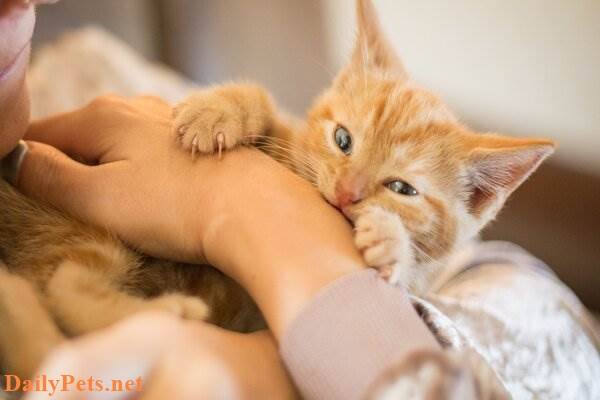However, there are times when your beloved cat may suddenly attack, causing harm to its owner. Besides the physical pain, cat scratches or bites can lead to infections, so it’s best to prevent such situations. Learning to prevent and respond to cat scratching and biting can be very useful.

Response to Cat Biting and Scratching
Stay calm
Never hit, shout, chase, or get angry with the cat. Such reactions will only make it scared and agitated.
Never call the cat over to punish it. Cats cannot understand why you’re reacting negatively towards them. Cats usually only respond to affection when you call them.
Exiting the Situation
The first thing to do is to withdraw your hand and keep it out of the cat’s reach. If the cat remains agitated for a few seconds, slowly stand up and move away to let the cat calm down. Leave the area and don’t return until the cat is calm.
Avoid petting the cat immediately after it scratches or bites. You should convey a sense of disapproval. After disciplining the cat, refrain from immediately comforting or petting it, as this can send conflicting signals and make the cat confused. It might start biting you to seek affection.
Allowing the Cat to Escape
If you find yourself in a situation where you’re trying to move to another room, but there’s a growling, hissing cat blocking your way, consider the situation from the cat’s perspective. The cat likely feels trapped, and you’re seen as a threat as you approach it. The cat wants to escape but may resort to aggression as it has no escape route. The simple solution here is to step aside and let the cat pass (it will likely run away) while you return to your intended path.
Do not feed the cat within 20 minutes after scratching or biting, as this may be mistakenly interpreted as a reward for the behavior.
Understanding What Encourages Behavior Change in Cats
Cats respond best to positive reinforcement, such as praise and rewards for good behavior, while ignoring or not rewarding inappropriate behavior.
Provide your cat with a catnip-stuffed toy as a substitute for you.
Praise the cat when it bites the toy.
Try using verbal and non-verbal cues
Immediately after the cat bites or scratches, say “NO” firmly while pointing your finger at the cat. Maintain a stern or serious gaze. In the cat’s world, prolonged eye contact signifies a threat or dominance. This can also help create distance between you and the cat after a scratching or biting incident.
Consider using a clapping method
When the cat bites or scratches, clap your hands and say “NO!” with a firm tone. Remember not to scold or clap directly in the cat’s face, as this can frighten it. Repeat this whenever the cat engages in biting or scratching behavior. Your cat will learn to give up these bad habits.

This method is effective for dominant, aggressive, or feisty cats but is not recommended for shy or fearful cats, as it may exacerbate those traits.
Try the “ignore” approach
When the cat stops biting or scratching, stand up and turn away without interacting with it for 5-10 minutes. Repeat this each time the cat attempts to bite or scratch you. It will associate its bad behavior with your indifference.
This approach doesn’t work for every cat but is effective for attention-seeking cats, as they prefer positive attention.
Preventing Cat Biting and Scratching
Teach kittens acceptable boundaries during playtime. Learn to mimic a cat’s behavior. When a kitten nibbles on your hand, make a high-pitched noise and pull your hand away. Then, stand up and walk away, signaling the end of playtime. If you’re consistent, the kitten will learn that biting ends the fun and will avoid doing it.
If your cat only playfully nibbles, but you want to prevent this behavior, gently resist. The cat will be uncomfortable when met with resistance and will stop biting. Quickly withdraw from rough play or biting if you might get scratched.
Use toys for playtime instead of your hands or fingers. Cats can become engrossed in play and may accidentally scratch or continue to bite you. To prevent this, offer cat toys like feather wands, laser pointers, or catnip-filled mice.
Cats have a natural need to bite, chew, and scratch for play and exercise. However, you should never let your cat practice these behaviors on you or anyone else. Try playing with your cat using a fishing pole-style toy, so your hand doesn’t have to endure biting.
Giving Your Cat Ample Playtime
Schedule daily playtime with your cat for 5-10 minutes. Let the cat chase a fishing pole toy until it gets tired.
Encourage your cat to engage in stalking and pouncing behaviors and expend energy during play. A tired cat is less likely to become aggressive than a bored cat with excess energy.
Consider Spaying or Neutering Your Cat
Cats not spayed or neutered tend to be more territorial than spayed or neutered cats. While not all unaltered cats are aggressive, spaying or neutering often has a calming effect and can make a cat more docile and friendly.
Understanding the Reasons Why Cats Bite or Scratch
Identify whether your cat was orphaned and raised by humans from a young age
Kittens raised without their mother may not learn appropriate boundaries in play and aggression. These cats may become aggressive as adults without apparent cause.
Cats raised by humans from a young age often show subtle signs that they are about to become aggressive. Learning to recognize these signs is essential to prevent being bitten or scratched.
Determine if your cat is stressed or fearful
When stressed and cornered with no escape, cats can become “aggressive.” Stress can result from a toddler making a loud noise, environmental changes, or the presence of a stranger. It’s crucial to understand your cat’s emotional needs and responses. Don’t assume the cat is aggressive; it may be reacting to stress.
The best response is to remain calm and create a peaceful environment. Turn off a loud TV, ask children not to make noise around the cat, and if someone is upset, have them go to another room to cry or yell.
Determine if your cat is just playing too roughly
If you often encourage your cat to attack by wiggling your fingers or toes during play, don’t be surprised if your cat continues to scratch or bite even after playtime ends. Your cat might still think it’s playtime.
Check if your cat is sick or in pain
Cats in pain or unwell may adopt a defensive attitude and might be more prone to aggression. Cats with signs of illness (weight loss, excessive thirst, vomiting) or pain (easily agitated, vocalizing, scratching, biting) should be taken to the veterinarian for an examination. Addressing underlying health issues can often improve a cat’s behavior.
Elderly cats may not enjoy being picked up or cuddled and may bite or scratch to be left alone. Remind everyone to be mindful of your cat’s age and handle them gently. Providing your cat with more space can also help prevent behavioral issues.
Understanding these factors can help you better respond to your cat’s behavior and prevent biting or scratching incidents. It’s essential to create a safe and stress-free environment for your cat and address any underlying issues contributing to aggressive behavior.





